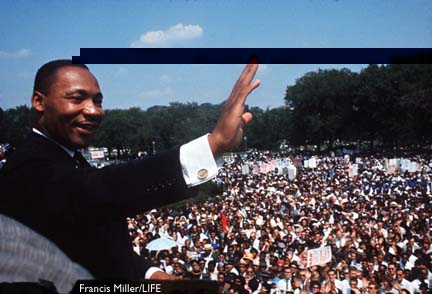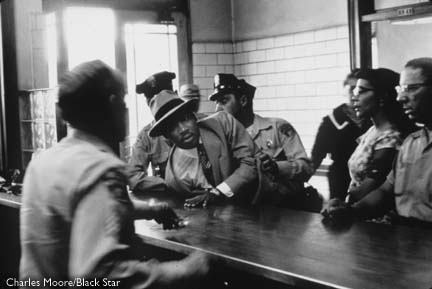|
�Today was a dark day in Birmingham. The
policemen were mean to us. They got their violent, angry dogs and
turned them loose on nonviolent people, unarmed people. But not only
that, they got their water system working. And here and there we saw
the water hose, with water pouring on young boys and girls, old men
and women, with great and staggering force. Birmingham was a mean
city today. But in spite of the meanness of Birmingham, we must
confront her with our kindness and our goodness and our
determination to be nonviolent. As difficult as it is, we must meet
hate with love. As hard as it is, we must meet physical force with
soul force.... Just let them get their dogs and let them get their
hose, and... we will leave them standing before their God and world
covered with the blood and reeking with the stench of their Negro
brothers.�
- Birmingham,
Alabama
May
3, 1963
�Violence
as a way of achieving racial justice is both impractical and
immoral. It is impractical because it is a descending spiral
ending in destruction for all. It is immoral because it seeks to
humiliate the opponent rather than win his understanding; it seeks
to annihilate rather than to convert. Violence is immoral because it
thrives on hatred rather than love.�
The Montgomery Bus Boycott
In 1955, Rosa Parks refused to give her bus
seat to a white passenger and was promptly arrested. Local NAACP
leaders saw this as an opportunity to strike a victory for Civil
Rights. King�s gift of public
speaking led to his being chosen as the president of the
Montgomery Improvement Association, the group that led the Montgomery
Bus Boycott.
The boycott
lasted for over a year, with over 90 percent of the blacks that
normally rode buses participating. The country was shown that
Southern blacks were ready to fight for their rights. Violent acts
against the protestors (police harassment and two bombings, among
other things), as well as King�s appeal for Christian brotherhood
gained media attention and support from Northern whites. In 1956, an
MIA attorney filed a lawsuit in federal court wanting a ruling
against segregation in Montgomery. The court ruled in the MIA�s
favor, ordering that the city�s buses be desegregated.
Montgomery�s city government appealed to the United States Supreme
Court, but the decision was upheld, striking a victory for civil
rights, for blacks, and for King.
Political Powers King Attacked
- Authority
� King and others defied the police and local governments by
his nonviolent protests against segregation laws.
- Human
Resources � Some people, both black and white, perpetuated
segregation laws by observing them without voicing against them.
- Skills
and Knowledge � Due to past segregation and oppression, the
blacks were less educated in some ways than the whites (and in
fact segregation in education was one of the many things the
Civil Rights Movement fought against).
- Intangible
Factors � Most people in the south that perpetuated
segregation were following old norms from before the Civil War,
that blacks were lesser than whites because of their origin and
skin color. King sought to change those norms.
- Material
Resources � the authorities had power over money, jobs,
transportation, and most everything in the city.
- Sanctions
� The authorities harassed black carpoolers, bombs were set
off in the houses of King and E. D. Nixon, King was arrested for
speeding, and conspiracy charges were brought against King and
some other members of the MIA.
Methods King Used
Links
|

